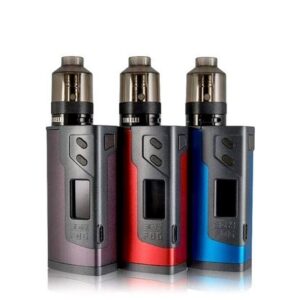E-Cigarettes (Starters Kit)
For new vapers, vape pens are a great transition into vaping. They have elegant designs, are easy to use and deliver enough vapor for a satisfying experience. For experienced vapers who typically use box mod kits, vape pens make awesome secondary devices; on-the-go mods that can easily be carried around without the bulk and weight of a box mod.
An electronic cigarette is an electronic device that simulates tobacco smoking. It consists of an atomizer, a power source such as a battery, and a container such as a cartridge or tank. Instead of smoke, the user inhales vapor. As such, using an e-cigarette is often called “vaping”. The atomizer is a heating element that atomizes a liquid solution called e-liquid. E-cigarettes are activated by taking a puff or pressing a button. Some look like traditional cigarettes, and most versions are reusable.
E-cigarettes create an aerosol, commonly called vapor, made of particulate matter. The vapor typically contains propylene glycol, glycerin, nicotine, flavors, and traces of nitrosamines, other toxicants, carcinogens, heavy metals, and metal nanoparticles. Its exact composition varies, and depends on several factors including user behavior.
The health effects of electronic cigarettes remain uncertain, but they are likely less harmful than smoking tobacco. E-cigarette vapor contains fewer toxic chemicals, in lower concentrations, than cigarette smoke, but also contains harmful chemicals not found in tobacco smoke.
Nicotine is highly addictive, and can be toxic at high levels, although poisoning is almost impossible when products are used as directed; however, accidental ingestion can be fatal. People who vape are more likely to start smoking. For smokers who are unable or unwilling to quit using conventional smoking cessation methods such as nicotine replacement therapy (NRT), vaping has a role in tobacco harm reduction.
POPULARITY (USAGE OF ELECTRONIC CIGARETTES)
E-cigarette use rose exponentially. In 2011 there were about 7 million adult e-cigarette users globally, rising to 41 million in 2018 and to 68 million in 2020 compared with 1.1 billion cigarette smokers.
E-cigarette use is highest in China, the US, and Europe, with China having the most e-cigarette users. In the UK, growth was slowing as of January 2018. The rise was thought to be due to advertising to young people; their low cost compared to tobacco; and the perception that e-cigarettes are safer than tobacco.
US
In 2018, current (30 day) e-cigarette use was about 20% in American high school students and about 3% in adults.
UK
In the UK, users increased from 700,000 in 2012 to 2.6 million in 2015. About 60% of UK users are smokers and about 40% are ex-smokers, while use among never-smokers in the UK is negligible.
AUSTRALIA
Approximately 520,000 of adult Australians were vaping İN 2019. That was more than twice as much as in a 2016 where only 240,000 of Australians were vapers.
PROGRESSION
Many users begin with a disposable e-cigarette resembling a tobacco cigarette. They often progress to later-generation devices and may adjust their devices to provide more vapor. Experienced users often prefer rechargeable e-cigarettes. Women prefer disposable e-cigarettes, and young adults pay more attention to modifiability. Modifiability increases the chance of starting vaping among young people.
Most vapers use a refillable tank system, allowing them to mix their own liquid giving control over flavor and strength. Experienced vapers rank customizability as the most important consideration in choosing a device. Users ranked nicotine strength as an important factor for choosing among various e-cigarettes, though such preference could vary by smoking status, e-cigarette use history, and gender. Non-smokers and inexperienced e-cigarettes users tended to prefer no nicotine or low nicotine e-cigarettes while smokers and experienced e-cigarettes users preferred medium and high nicotine e-cigarettes.
YOUNG PEOPLE
Worldwide, increasing numbers of young people are vaping; more in some countries than others. With access to e-cigarettes, young people have been using tobacco about a quarter as often. Vaping among adolescents grew every year until 2017. There appears to be an increase of one-time e-cigarette use among young people worldwide.
Most young e-cigarette users have never smoked, but there is a substantial minority who both vape and smoke, which indicates that e-cigarettes may be a starting point for nicotine use. Young people who would not smoke are vaping, and young people who vape are more likely to start smoking. Twice as many young people vaped in 2014 than also used traditional cigarettes. Young people who smoke tobacco or marijuana, or who drink alcohol, are much more likely to vape. Among young people who have tried vaping, most used a flavored product the first time.
Most young people are not vaping to help them quit tobacco. Vaping correlates with smoking among young people, even in those who would otherwise be unlikely to smoke. Experimenting with vaping encourages young people to continue smoking. In 2015, minors had little resistance to buying e-cigarettes online. Teenagers may not admit using e-cigarettes, but use, for instance, a hookah pen. As a result, self-reporting may be lower in surveys.
MOTIVATION
There are varied reasons for e-cigarette use. Most users are trying to quit smoking, but a large proportion of use is recreational or as a way to get around smoke-free laws. Most still smoke, raising concern that dual use may “delay or deter quitting”. Some people say they want to quit smoking by vaping, but others vape to circumvent smoke-free laws and policies, or to cut back on cigarette smoking. Many vape because they believe vaping is safer than smoking.
Concerns over avoiding stains on teeth or odor from smoke on clothes in some cases prompted interest in or use of e-cigarettes. Some e-cigarettes appeal considerably to people curious in technology who want to customize their devices. There appears to be a hereditary component to tobacco use, which probably plays a part in transitioning of e-cigarette use from experimentation to routine use. Users say they like the choice of flavors and comparatively low price.
CONSTRUCTION AND HOW IT WORKS
An electronic cigarette consists of an atomizer, a power source such as a battery, and a container for the e-liquid such as a cartridge or tank.
E-cigarettes have evolved over time, and the different designs are classified in generations. First-generation e-cigarettes tend to look like traditional cigarettes, though there is some variation in size, and so are called “cigalikes”. Second-generation devices are larger overall and look less like traditional cigarettes. Third-generation devices include mechanical mods and variable voltage devices. The fourth-generation includes Sub ohm tanks (meaning that they have electrical resistance of less than 1 Ohm) and temperature control devices. The voltage for first-generation e-cigarettes is about 3.7 and second-generation e-cigarettes can be adjusted from 3 V to 6 V, while more recent devices can go up to 8 V. There are also pod mod devices that use protonated nicotine, rather than free-base nicotine found in earlier generations, providing higher nicotine yields through the production of aerosolized protonated nicotine.
E-liquid is the mixture used in vapor products such as e-cigarettes. It usually contains propylene glycol, glycerin, nicotine, flavorings, additives, and contaminants. E-liquid formulations vary widely. A typical e-liquid comprises propylene glycol and glycerin (95%), and flavorings, nicotine, and other additives (5%). Some e-liquids lack propylene glycol, nicotine, or flavors. The flavorings may be natural, artificial, or organic. Over 80 chemicals such as formaldehyde and metallic nanoparticles have been found in the e-liquid. There are many e-liquid manufacturers, and more than 15,000 flavors.
In the US, under Food and Drug Administration (FDA) rules, e-liquids must comply with manufacturing standards. Industry standards are published by the American E-liquid Manufacturing Standards Association (AEMSA). EU standards are in the EU Tobacco Products Directive.
Showing 1–9 of 17 results









